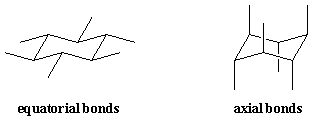For OChem 1, I was doing subject test 2. For number 22 I ran into a question where i had to put substituents in axial and equatorial positions and in the explanation there was a rule "if members of rings are trans and even number carbon apart they will occupy opposite positions and for odd numbers carbons apart they will occupy same relative position." I did not really understand the explanation. Can you please elaborate on that? Also, does the same rule apply for cis?
----------------
This question asks us to decide axial versus equatorial for the molecule trans-1-bromo-3-tert-butylcyclohexane. In other words, cyclohexane with a "down" bromine, and an "up" t-butyl group two carbons away.
First consideration here goes to the bulkiest group. Here, that's the tert-butyl group. That will definitely want to be equatorial. Now that we know that, let's think about the bromine. This is what the Kaplan answer is trying to explain: if a group is "equatorial" on what we'll call carbon 1, and it's "up" (as is the case here), then the "up" group on carbons 3 and 5 are also equatorial; the "up" groups on carbons 2, 4, and 6 are axial. Think about what cyclohexane looks like:

This would not be the case for cis - with cis, the t-butyl group would still prefer the equatorial position, and the bromine (2 carbons away) could also be equatorial if it's "up" too.
I hope this helps. If you need me to explain it at class, I certainly can. It often requires some drawing and that might be hard to communicate in the blog.
No comments:
Post a Comment